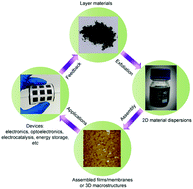Preparation of 2D material dispersions and their applications
Abstract
Extensive research on two-dimensional (2D) materials has triggered the renaissance of an old topic, that is, the intercalation and exfoliation of layer materials. Such top-down exfoliation produced 2D materials and their dispersions have several advantages including low cost, scalable production capability, solution processability, and versatile functionalities stemming from the large number of species of layer materials, and show promising potential in many applications. In recent years, many new methods have been developed for exfoliating layer materials to 2D materials for different application purposes. In this review the different exfoliation approaches are first systematically analyzed from the viewpoint of methodology, and the advantages and disadvantages of each method are compared. Second, the assembly of exfoliated 2D materials into macrostructures by solution-based techniques is summarized. Third, the state-of-the-art applications of 2D material dispersions and their assemblies in electronics and optoelectronics, electrocatalysis, energy storage, etc., are discussed. Finally, insights and perspectives on current research challenges and future opportunities regarding the exfoliation and applications of 2D materials in dispersions are considered.

- This article is part of the themed collection: 2D nanomaterials: beyond graphene and transition metal dichalcogenides


 Please wait while we load your content...
Please wait while we load your content...